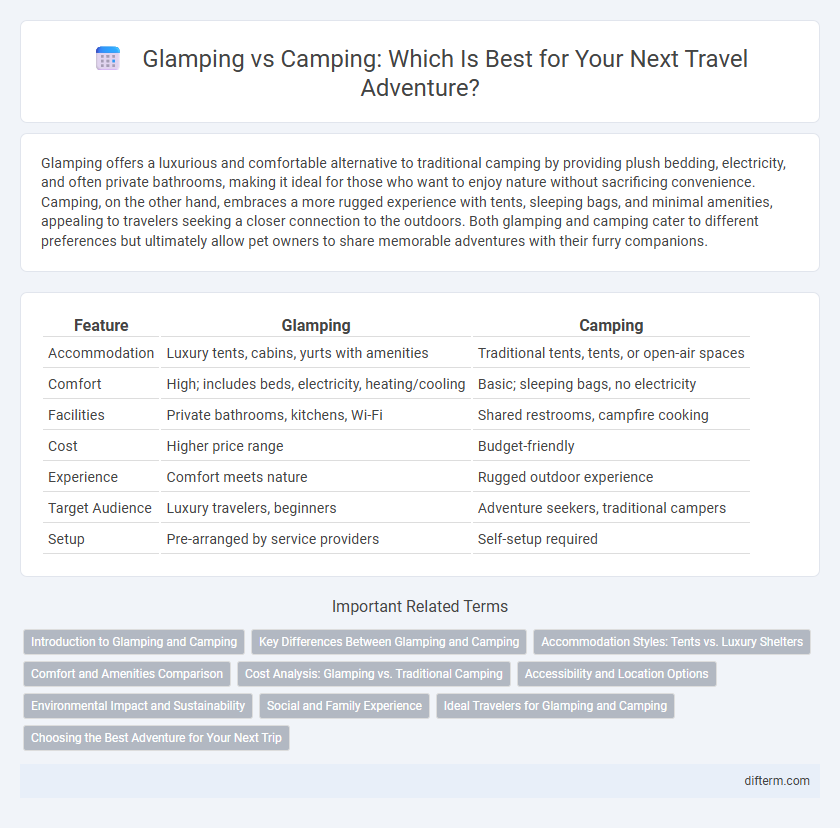Glamping offers a luxurious and comfortable alternative to traditional camping by providing plush bedding, electricity, and often private bathrooms, making it ideal for those who want to enjoy nature without sacrificing convenience. Camping, on the other hand, embraces a more rugged experience with tents, sleeping bags, and minimal amenities, appealing to travelers seeking a closer connection to the outdoors. Both glamping and camping cater to different preferences but ultimately allow pet owners to share memorable adventures with their furry companions.
Table of Comparison
| Feature | Glamping | Camping |
|---|---|---|
| Accommodation | Luxury tents, cabins, yurts with amenities | Traditional tents, tents, or open-air spaces |
| Comfort | High; includes beds, electricity, heating/cooling | Basic; sleeping bags, no electricity |
| Facilities | Private bathrooms, kitchens, Wi-Fi | Shared restrooms, campfire cooking |
| Cost | Higher price range | Budget-friendly |
| Experience | Comfort meets nature | Rugged outdoor experience |
| Target Audience | Luxury travelers, beginners | Adventure seekers, traditional campers |
| Setup | Pre-arranged by service providers | Self-setup required |
Introduction to Glamping and Camping
Glamping combines the adventure of camping with the comfort of luxury accommodations, offering fully equipped tents, cabins, or yurts featuring amenities such as comfortable bedding, electricity, and climate control. Traditional camping involves setting up tents and living with minimal facilities, emphasizing a closer connection to nature and outdoor survival skills. Both options provide unique outdoor experiences, with glamping appealing to travelers seeking convenience and style while camping attracts those desiring simplicity and ruggedness.
Key Differences Between Glamping and Camping
Glamping offers luxurious amenities like comfortable beds, electricity, and private bathrooms, contrasting with traditional camping's reliance on basic tents and portable gear. While camping emphasizes a rugged outdoor experience with self-sufficiency, glamping provides convenience and comfort, often in unique accommodations such as yurts or treehouses. The cost difference is significant, with glamping typically requiring a higher budget compared to the minimal expenses associated with camping equipment and campsites.
Accommodation Styles: Tents vs. Luxury Shelters
Glamping offers luxurious shelters such as yurts, cabins, and safari tents equipped with plush bedding, electricity, and climate control, providing a comfortable and stylish alternative to traditional camping tents. Traditional camping relies on portable tents that prioritize functionality and compactness, often lacking modern amenities but delivering an authentic outdoor experience. Choosing between glamping and camping depends on desired comfort levels, with glamping catering to travelers seeking upscale accommodation in nature.
Comfort and Amenities Comparison
Glamping offers enhanced comfort with luxurious amenities such as plush bedding, electricity, private bathrooms, and climate control, creating a hotel-like experience in nature. Traditional camping provides a more rustic, minimalist approach, relying on tents, sleeping bags, and communal facilities, which may lack modern conveniences. The choice between glamping and camping hinges on the desire for comfort versus an authentic outdoor experience.
Cost Analysis: Glamping vs. Traditional Camping
Glamping typically involves higher upfront costs due to luxury accommodations like furnished tents, yurts, and cabins, with prices averaging $150 to $400 per night compared to traditional camping, which can cost as little as $10 to $50 per night for tent sites. While traditional camping requires purchasing gear such as tents, sleeping bags, and cooking equipment, glamping includes amenities that reduce the need for extra expenses on supplies. The overall cost analysis shows that glamping offers convenience and comfort at a premium price, whereas camping provides a budget-friendly option with potential additional costs for gear and transportation.
Accessibility and Location Options
Glamping offers enhanced accessibility with comfortable accommodations such as cabins, yurts, and RVs that accommodate varying mobility needs, unlike traditional camping which often requires navigating uneven terrain and setting up tents. Glamping sites are commonly found in more diverse and convenient locations, including luxury resorts, national parks, and private estates, expanding options beyond the remote wilderness spots typical of camping. This accessibility combined with broader location choices makes glamping a preferred option for travelers seeking comfort without sacrificing proximity to nature.
Environmental Impact and Sustainability
Glamping significantly reduces environmental impact by utilizing eco-friendly materials, renewable energy sources, and waste management systems, whereas traditional camping often leaves a larger footprint through campfires, litter, and soil degradation. Sustainable glamping sites prioritize conservation efforts and support local ecosystems by minimizing resource consumption and promoting biodiversity. Choosing glamping over camping can contribute to more responsible tourism practices while offering a comfortable outdoor experience.
Social and Family Experience
Glamping offers a luxurious social and family experience with spacious, comfortable accommodations that encourage group bonding and shared activities without sacrificing privacy. Traditional camping promotes deeper connections through hands-on outdoor tasks like setting up tents and cooking over a fire, fostering teamwork and resilience. Both options enhance family togetherness, but glamping provides a more convenient, stress-free environment suited for diverse age groups.
Ideal Travelers for Glamping and Camping
Glamping appeals to travelers seeking comfort, luxury, and convenience in nature, such as families, couples, or those new to outdoor experiences who prefer amenities like cozy beds and electricity. Traditional camping attracts adventure enthusiasts, budget-conscious backpackers, and nature purists who enjoy rugged environments, self-sufficiency, and immersive outdoor activities like hiking and fishing. Both options cater to distinct preferences, with glamping suited for relaxation and style, while camping fulfills the desire for authentic wilderness exploration.
Choosing the Best Adventure for Your Next Trip
Glamping offers a luxurious outdoor experience with comfortable amenities such as plush beds, electricity, and private bathrooms, ideal for travelers seeking nature without sacrificing comfort. Camping provides a more traditional, rugged adventure, allowing enthusiasts to connect deeply with nature through activities like hiking and campfire cooking. Selecting between glamping and camping depends on your desired balance of convenience, adventure, and immersion in the natural environment for your next trip.
glamping vs camping Infographic

 difterm.com
difterm.com